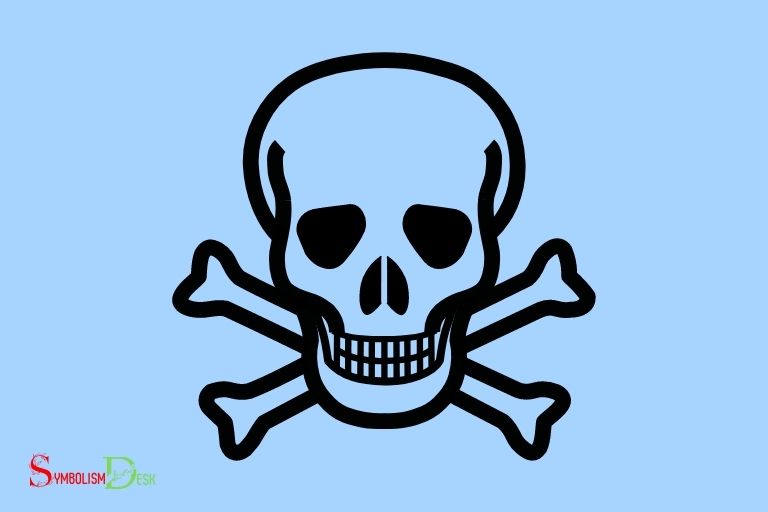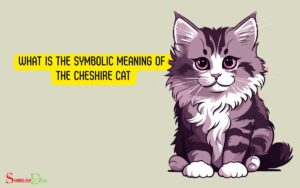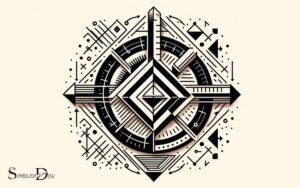What Does Skull And Crossbones Symbol Mean? Death!
The skull and crossbones symbol is a representation of danger, death, or poison, often used as a warning or precautionary measure.
The skull and crossbones symbol, also known as the Jolly Roger, has been used for centuries to evoke fear and convey an imminent threat.
Historically, it was often associated with piracy, as pirates hoisted the ominous flag on their ships to intimidate and terrorize their targets.
Today, the symbol is commonly found on hazardous materials, toxic substances, and deadly chemicals to alert people of the potential dangers associated with handling or consuming them.
The skull and crossbones symbol has undeniably left its mark on history, serving as a universal sign of danger and death.
Even in today’s modern world, the symbol maintains its relevance by alerting those who encounter it to take necessary precautions to ensure their safety.
Despite its dark connotations, the skull and crossbones have also found their way into popular culture, becoming an iconic emblem in various forms of media, fashion, and art.
Detailed Interpretations of the Skull and Crossbones Symbol
| Symbol | Meaning |
|---|---|
| Skull and Crossbones | The skull and crossbones is a symbol consisting of a human skull and two long bones crossed together under or behind the skull. The symbol has multiple meanings, largely influenced by the context in which it is used: |
| 1. Piracy: Historically, it was used in the pirate flags and is hence commonly associated with pirates. | |
| 2. Danger or Poison: On product labels, it indicates that the substance is harmful, poisonous or lethal. | |
| 3. Death: The symbol is often used to represent death or danger. | |
| 4. Military Units: It’s sometimes used in military insignia to represent toughness, daredevilry, and fearlessness in the face of death. | |
| 5. Fraternities and Societies: Many fraternities, clubs and secret societies—such as Yale University’s Skull and Bones—use the symbol. |
Key Takeaway

Five Facts About: The Skull and Crossbones Symbol
The Origins Of Skull And Crossbones Symbol
Understanding The Meaning Of Jolly Roger
The skull and crossbones symbol is often associated with the jolly roger flag flown by pirates. But what exactly does the jolly roger mean?
Here are the key points to understand:
- Jolly roger is a flag flown by pirates to denote that no mercy would be shown to their enemies.
- The flag helped intimidate and scare off merchant ships without firing a single shot.
- Jolly roger’s meaning has varied globally and over time. It was often used by pirates to signal their identity.
The Connection Between Pirates And Skull And Crossbones Symbol
Pirates have long been associated with the skull and crossbones symbol, but what’s the reasoning behind this association?
Here are the key points:
- The pirates viewed themselves as outsiders and rebels in the society.
- The skull and crossbones symbol was a mark of their “otherness” and anti-establishment sentiments.
- The imagery also helped to strike psychological fear and terror into their enemies’ hearts.
Historical Use Of Skull And Crossbones Symbol
The skull and crossbones symbol has had various meanings throughout history.
Here are some of the historical uses of the symbol:
- In ancient rome, the skull and crossbones were used as a warning to stay away from dangerous places, such as where plague victims were buried.
- It was a symbol used by medieval knight order “the order of the skull and bones.”
- The symbol has seen use in the military as well, such as the death’s head battalion of the waffen-ss.
- Today, it’s still used by several military and law-enforcement groups, but with different meanings.
The skull and crossbones symbol is complex and has been used in many ways, from the feared jolly roger flag flown by pirates to its current-day use by the military.
Regardless of its meaning, it will forever be an iconic and recognizable symbol.
Interpretations And Symbolic Meanings Of Skull And Crossbones Symbol
The skull and crossbones symbol is often associated with pirates and danger. But what does this symbol truly mean?
We will uncover the different interpretations and symbolic meanings behind the skull and crossbones symbol. Let’s dive in!
Death And Mortality: The Dark Meanings Behind The Symbolism
The skull and crossbones symbol has been historically associated with death and mortality.
Here are some key points to consider about its dark meanings:
- It symbolizes the fragility of life and reminds us that we should enjoy life to its fullest.
- The symbol was used during the black death pandemic in medieval europe to mark infected houses.
- It has been used as a warning sign for poisonous substances, hazardous materials, and biohazardous waste.
Cultural And Religious Interpretations Across The Globe
The skull and crossbones symbol is not only associated with death and mortality. It has various cultural and religious interpretations.
Here are some key points to consider:
- In mexico, the skull and crossbones symbolize the day of the dead, a celebration to honor deceased relatives and ancestors.
- In hinduism, kali, the goddess of destruction and transformation, is often portrayed wearing a necklace made of skulls.
- Some christian traditions depict the cross with a skull and crossbones at its base, symbolizing jesus’s victory over death and resurrection.
Positive Interpretations: Reincarnation, Resurrection, And Liberation
The skull and crossbones symbol may represent negative connotations to some, but it can also hold positive meaning.
Here are key points to consider:
- In some cultures, the skull and crossbones symbol is seen as a representation of reincarnation, emphasizing the idea that death is a part of a continuous cycle of life.
- In christianity, the skull and crossbones symbolize resurrection and liberation, reminding us that death is not the end, but rather the beginning of eternal life.
The skull and crossbones symbol may hold negative connotations for many, but it also carries positive meanings across various cultures and religions.
Its interpretation ultimately depends on the individual’s perception of life and death.
Skull And Crossbones In Popular Culture
Skull and crossbones symbol is not just a mere depiction of death or danger. It has a much more profound significance in popular culture in the modern era. Let’s explore this aspect of the symbol further.In recent years, the skull and crossbones symbol has been adopted by various subcultures, from punk rock to streetwear fashion, as a rebellious and edgy icon. However, its origins can be traced back to the pirate flags of the 18th century. The symbol has also been used as a warning sign for toxic substances or hazardous materials. In the paramedic symbol explained, the skull and crossbones are often used to denote poison or hazards, serving as a universal warning for potential danger.
Depiction Of Skull And Crossbones Symbol In Modern Media
The portrayal of the skull and crossbones symbol in modern media is more diverse than ever before.
Here are some key points:
- The symbol is synonymous with piracy and is seen in movies, tv shows, cartoons, and video games.
- It has become a popular design element for the cover art of heavy metal and rock music albums.
- Sports teams have also adopted the skull and crossbones symbol as their official team emblem.
Usage In Fashion And Art Industry
Skulls and crossbones have become a trendy fashion and art statement in recent years.
Here’s what you need to know:
- Fashion labels have incorporated skull and crossbones symbols into their collections. It’s now common to see clothes, shoes, and jewelry emblazoned with the symbol.
- Skulls and crossbones are popular motifs in contemporary art, graffiti, and streetwear culture. Some pieces use skulls as their primary theme, while others integrate the symbol into their overall aesthetic.
Significance In Niche Communities And Groups
The skull and crossbones symbol has become a symbolic icon in different groups and niche communities.
Here are some examples:
- The symbol is closely associated with the punk subculture and represents rebellion and non-conformity.
- Many biker gangs use the skull and crossbones symbol as part of their emblem, signifying their defiance and independence.
- The symbol has become a significant component of the military culture, often featuring in military patches and insignias.
In Conclusion
The skull and crossbones symbol has evolved to become more than just a representation of death.
In modern times, it carries various meanings and connotations, and its influence continues to grow.
Whether in popular culture, fashion, art, or niche communities, the skull and crossbones symbol persists as a powerful icon of resilience, strength, and rebellion.
Legal And Safety Implications Of Skull And Crossbones Symbol
Skull And Crossbones In Warning Labels And Product Packaging
The skull and crossbones symbol is commonly used as a warning sign on hazardous materials and products, to alert consumers and users of potential dangers.
Here are some key points about the use of this symbol in warning labels and product packaging:
- The symbol is used to warn people of immediate danger, indicating that the product or material is toxic, corrosive, flammable, or explosive.
- The symbol is often accompanied by words such as “poison”, “danger”, “warning”, or “caution”, to provide further information about the nature of the hazard.
- The symbol should be prominently displayed on the label or packaging, with clear and legible markings, to ensure that it is easily recognizable and understandable.
Legal Implications Of Unauthorized Usage Of The Symbol
The skull and crossbones symbol is a registered trademark in many countries, and its unauthorized use can lead to legal and financial consequences.
Here are some key points to consider:
- The symbol is protected under copyright law, and it can only be used with the permission of the trademark owner.
- Unauthorized usage of the symbol can lead to legal action, including lawsuits for trademark infringement and damages.
- Misuse of the symbol can also lead to safety hazards if it is used incorrectly or inappropriately, resulting in liability for the user or manufacturer.
Additional Safety Symbols And Implications
In addition to the skull and crossbones symbol, there are many other safety symbols and implications to consider when handling hazardous materials and products.
Here are some examples:
- The flame symbol indicates that the substance is flammable or combustible.
- The biohazard symbol indicates that the substance is infectious or hazardous to health.
- The radiation symbol indicates that the material emits ionizing radiation.
- The electric shock symbol indicates that the material is capable of causing electric shock or electrocution.
Understanding these safety symbols and implications is essential for ensuring proper handling and usage of hazardous materials and products, and for minimizing risks to health and safety.
Was Hera’s Marriage to Zeus a Happy One?
Hera’s marriage to Zeus, despite its complexities, was far from a happy one. As the queen of the gods, her role was crucial, but Zeus’s constant infidelities caused immense pain. Despite her power and hera’s symbol meaning explained as the peacock, her union with Zeus was marked by tension, jealousy, and a lack of true happiness.
FAQ About What Does Skull And Crossbones Symbol Mean
What Is The Meaning Of The Skull And Crossbones Symbol?
The skull and crossbones represent death, danger, and poison. Pirates also used it as a jolly roger flag.
Why Is The Skull And Crossbones Associated With Pirates?
Skull and crossbones represent piracy and were used to strike fear into the hearts of sailors.
Where Else Is The Skull And Crossbones Symbol Used?
The symbol is used in medicine to indicate poisonous substances and in hazardous areas as a warning.
Is The Skull And Crossbones Symbol Copyrighted?
The symbol is not copyrighted and is in the public domain. It can be used for any purpose.
Can The Skull And Crossbones Symbol Have A Positive Meaning?
The symbol can be used positively. For example, it represents resilience and bravery to soldiers.
Conclusion
After an in-depth analysis of the skull and crossbones symbol, it is clear that it has both positive and negative connotations.
While it is commonly associated with danger, piracy, and death, the symbol also has a rich history that extends beyond its negative connotations.
Today, the skull and crossbones symbol is widely recognized across different cultures and is commonly used in fashion, art, and entertainment.
The meaning behind the symbol differs depending on the context it is being used in but has mostly become a universally recognized symbol of rebellion, strength, and perseverance.
It is undoubtedly one of the most recognizable symbols known to man, and regardless of its history and origins, it remains an iconic and evocative design that will continue to capture the imagination of people for years to come.






